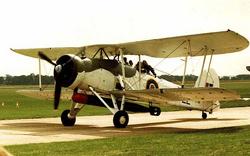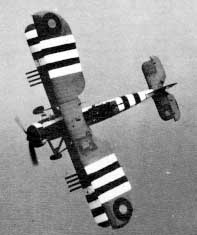We are developing the social individualist meta-context for the future. From the very serious to the extremely frivolous... lets see what is on the mind of the Samizdata people.
Samizdata, derived from Samizdat /n. - a system of clandestine publication of banned literature in the USSR [Russ.,= self-publishing house]
|
Historic stringbags There was a documentary about the Royal Navy in WWII on tonight, and one image etched itself into my mind. With a sidescan sonar they found the wreck of the Ark Royal, and along the debris path there was an unmistakeable outline.
A Fairey Swordfish!
This is not just any Fairey Swordfish. This is one of the survivors of Bismark torpedo raids of May 1941. It is sitting at the bottom of the Mediterranean, certainly with all the fabric gone, but still sufficiently intact to give image enough for type recognition.
My mind is boggled at the find and I still find it hard to believe.
I simply cannot wait until someone figures out how to recover it. And if there is one, there might be more. Who knows? Perhaps the very plane that doomed the Bismark will one day grace the Imperial War Museum.

click for larger image
|
Who Are We? The Samizdata people are a bunch of sinister and heavily armed globalist illuminati who seek to infect the entire world with the values of personal liberty and several property. Amongst our many crimes is a sense of humour and the intermittent use of British spelling.
We are also a varied group made up of social individualists, classical liberals, whigs, libertarians, extropians, futurists, ‘Porcupines’, Karl Popper fetishists, recovering neo-conservatives, crazed Ayn Rand worshipers, over-caffeinated Virginia Postrel devotees, witty Frédéric Bastiat wannabes, cypherpunks, minarchists, kritarchists and wild-eyed anarcho-capitalists from Britain, North America, Australia and Europe.
|






For people like myself who had never heard of the Fairey Swordfish, here is a link.
Unfortuneately I do not (yet) have a photo a Swordfish in my extensive photo library. My “B Roll” as I jokingly call it. We’re looking for a good ‘open source’ photo of a particular kind and will add it when found.
I hope they can recover it someday.
Those guys had guts, flying those antiquated birds into the Bismarck’s AA guns. God rest their souls.
The scenes in the movie “Sink the Bismarck” where the Swordfish are attacking were very well, as I recall.
I read somewhere that the Swordfish flew so slow that it messed up the Bismarck’s AA. Something about the Bismarck’s fire control being set up for much faster planes.
Can anyone verify this?
The Bismarck things a myth, The constraints imposed in air dropping torpedoes mean even aircraft capable of much higher speeds will still be slowing down to fly profiles similar to the Swordfish.
Far from being antiquated, the Swordfish operating in the Mediterranean had fairly spohicated electrical kit, arguably making them the most advanced strike aircraft in the world, and proberbly the first aircraft with a genuine all weather capability. Rocket firing, radar equipped stringbags were still hunting Panzers over Belgium and Germany into 1945.
Simon is quite correct… obviously a Swordfish would be a dead duck if there was any unopposed enemy fighter opposition, but in the ETO/MTO, that was a rare thing for a carrier based aircraft to encounter… other than that, do not be decieved by the archaic airframe: the Swordfish was a highly successful and truly deadly aircraft right up to 1945 and was often equiped with advanced systems like centimetric radar capable of picking up a the periscope of a submerged U-boat at many miles range, plus sophisticated radio nav aids. For carrier based operations, the ‘Stringbag’ was a dream to fly (good range, stable, forgiving, very low stall speed and strong as hell). See here for a great Fleet Air Arm site.
I gather the Swordfish sank more tonnage than any other aircraft model in the Second World War. Though the variety of other countries’ air forces may have something to do with that.
Despite the ungainly appearance, the only thing wrong with the Stringbag was its pathetic speed. It had a tremendous endurance, a mammoth bombload, was very reliable and easy to launch and recover under night and bad weather conditions.
The speed though, was a problem: a number of aircraft escorting convoys were lost due to running out of fuel, when an unpredicted headwind caused their speed over ground to be cut from 80 knots to 50. Not good if you’re 120 NM away, and have only got 2 hours fuel.
Of course, if you think a Swordfish is ungainly, you’ve probably never seen a Walrus.
Strike aircraft always suffer when sent unescorted against fighter opposition. The small number of modern Avengers at Midway did not fare any better than the obsolete Devastators.
‘To War in a Stringbag’ by Cmdr. Charles Lamb is superb read, and discusses air combat between Swordfish and faster adversaries. Lamb was credited with 2 Me-109’s during an attack on HMS Illustrious. As I mentioned above, an encounter between a Swordfish and ME-262 is historically plausible (to my knowledge it never happened).
I think the SBD Dauntless could have a better claim to most Axis tonnage sunk. Air laid minefields also accounted for a very sizeable amount of shipping in both the ETO and PTO and its almost impossible for it to be credited to aircraft types.
The Walrus was allegedly braced for dive-bombing, I have a terrible feeling somewhere out over the Atlantic a Walrus is still trying to finish an attack on a patient U-boat below.
Simon,
638 enemy vessels are recorded sunk by the RAF’s gardening sorties in the Atlantic. Torpedoes and bombs accounted directly for 366 ships. By contrast, British subs sunk only196 vessels.
I doubt about that claim about tonnage
Think in pacific theatre or mediterranean one. Probably in mediterranean was the Stukas or SM79 italian torpedo bombers. Most british convoys to Malta were devastated with sometimes only a couple of ships surviving, or even retiring.
Or in pacific the US Avengers /Devastators.
But that doesnt deny that Swordfish was one of the most important aircraft against military ships. On the top of my head: taranto raid(put one italian battleship out for remaining war)
made Matapan possible letting to destruction of 3 heavy italian cruisers.
Bismark…
I have located a Fairey Swordfish Mark IV in the woods of Nova Scotia. It was based @ East Camp Fleet Air Arm base during WWII and crashed in 1944. All 3 crew survived crash and I have spoken to original pilot. This is the only remaining Mark IV on the planet as there were modified locally in Yarmouth, NS (winterized canopy for Navigator and rear gunner).
I served at the Naval Air Gunners School at Yarmouth N.S. 743 744 745 {Swordfish} Sqdns
I recollect the Swordfish crash you mention and remember the trainee A/G was a corporal Royal Marine who was commended for his action in recovering the Radios from the crashed A/C
Dear Mr. A.D. Scott-Coveney.
Could I kindly request your contact information so that I may contact you. telephone and/or email would be great!
Sincerely,
Gary
Dear Mr. Scott-Coveney.
My father served with the RCN and trained at No. 1 NAGS in Yarmouth. I would be delighted to have further contact with someone who shared some of his wartime experiences. He died in 2005.
I have a picture of him with a number of other men, wearing flight suits and standing in front of a building at the Yarmouth NAGS.
A handwritten note on the back lists the last names of the men as well as the name of the school. No date but we’re guessing 1944-45 because he never went overseas.
Also of interest, Vintage Wings of Canada–based in Gatineau, Quebec is currently restoring a Swordfish to airworthy status which they hope to complete by the end of this year.
For detailed information on the crash mentioned, visit
http://www.vintagewings.ca/page?a=504&lang=en-CA
Unfortunately, the pilot of the crashed Swordfish (Bert Joss) died last August (2008). His logbook can be seen at Vintage Wings of Canada.
Anastasia…could I have your contact information. I work with a non-profit group who has the most complete record of Yarmouth’s WWII history available, contacts in the Fleet Air Arm, etc and would love to chat. Phone number if you feel comfortable providing that would be great. I am sure there are many other photos we could share….
Sincerely
Gary